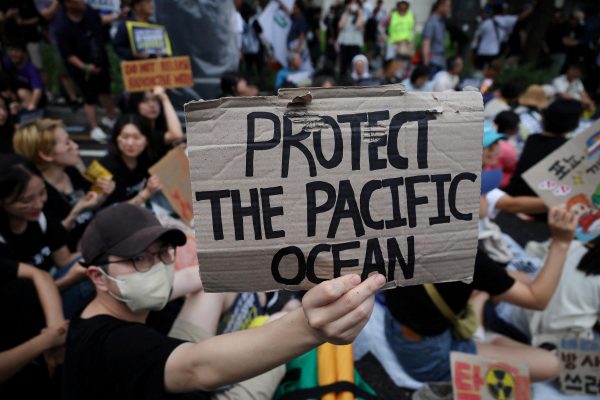The Kishida administration is returning to its policy of promoting nuclear power and the ocean release plan appears to be part of that strategy. Since 2021, at the request of the Japanese government, the International Atomic Energy Agency (IAEA) has been conducting safety assessments on the plan to dilute the accumulated treated water at the Fukushima Daiichi plant. In July 2023, the IAEA published a final report stating that ‘the proposed plan complies with international safety standards’. IAEA Director-General Rafael Grossi met with Prime Minister Fumio Kishida on 4 July to report that the ocean release plan was a viable option.
Japan’s Nuclear Regulation Authority (NRA) also granted Tokyo Electric Power Company (TEPCO) a certificate of completion for pre-use inspections, stating that there were no issues with the release-related facilities. With the approval of these agencies, the government is now expected to make the final decision to proceed with the scheduled release.
Both the government and TEPCO use the term ‘treated water’ to refer to water contaminated with tritium, a radioactive isotope of hydrogen. This isotype cannot be removed because it shares almost the same properties as ordinary water. TEPCO has insisted that releasing the treated water into the ocean is a normal part of nuclear plant operations around the world. But the Fukushima Daiichi water that was directly injected into damaged reactors and contaminated with fuel debris is different from the water normally used for cooling nuclear plants. The treated water also contains many other radioactive substances, albeit in low concentrations.
The implementation of the ocean release plan requires management to regularly monitor progress and reduce variance. Since the earthquake, Tokyo Electric Power Company has been continuously pumping water to cool the fuel rods at the Fukushima Daiichi Nuclear Power Plant. As a result, contaminated water is generated daily at the plant and stored in large tanks.
So far, over 1000 tanks have become full. Japan has explained that this measure is not a sustainable long-term solution. Tokyo Electric Power Company plans to gradually release this water into the Pacific Ocean over the next 30 years and asserts that the water is safe.
The IAEA will establish an office at the site and continue verification until the discharge is completed, but the NRA will also have an essential role in monitoring and guiding TEPCO.
The responses of various countries and other stakeholders to the ocean release are divided. Following the release of the IAEA report, the US State Department welcomed the IAEA assessment by noting that ‘Japan’s plans to release treated water from the Fukushima Daiichi nuclear site are safe and consistent with internationally accepted nuclear safety standards’. On 13 July, the European Union agreed to remove restrictions on Japanese food imports, noting that the ocean release will have ‘a negligible radiological impact on people and the environment’.
But unsurprisingly, concerns from neighbouring countries are growing. On 7 July, China’s customs department announced a ban on the import of food products from ten Japanese prefectures. The Chinese Ministry of Foreign Affairs criticised the Japanese government’s decision as ‘extremely irresponsible’ and stressed that the IAEA review was not an endorsement but merely indicated that the ocean release ‘was in line with the standards’.
South Korean opposition lawmakers and media also strongly oppose the plan, referring to the water as ‘contaminated’. The South Korean government continues to ban the import of seafood products from eight prefectures in Japan.
Eight years ago, the Japanese government and TEPCO promised the Fukushima Prefectural Federation of Fisheries that they would not take any action to dispose of treated water without stakeholders’ support. Fishing industry representatives, fearing reputational damage, still oppose the discharge.
For public accountability, the ocean release should not proceed as planned. The Japanese government should first carefully communicate its efforts to both domestic and international audiences. Given the limits of scientific prediction for large-scale nuclear energy projects, regulators will inevitably be involved in political decisions, as technology-induced risks are increasingly subject to social and political scrutiny.
At present, the Japanese government is continuing to avoid blame for its unpopular actions and has delegated the task of making politically costly choices to the IAEA and the NRA. Japan could instead manage social concerns by providing clear solutions. The Kishida cabinet must coordinate an accountability structure among stakeholders and fulfil its ultimate political responsibility in pursuing the collective goal of nuclear safety.
This coordination would require the Kishida administration to go beyond simply avoiding conflict and cooperate on solutions that can benefit all the organisations involved. To proceed with the ocean release, the Japanese government must address the remaining domestic and international concerns through adequate dialogue and ensure that the discharge procedure is carried out reliably with a well-communicated risk management plan. The government and TEPCO must strive for greater transparency to allay concerns and gain understanding.
Yasuo Takao is Adjunct Senior Research Fellow at the School of Media, Creative Arts and Social Inquiry at Curtin University.

